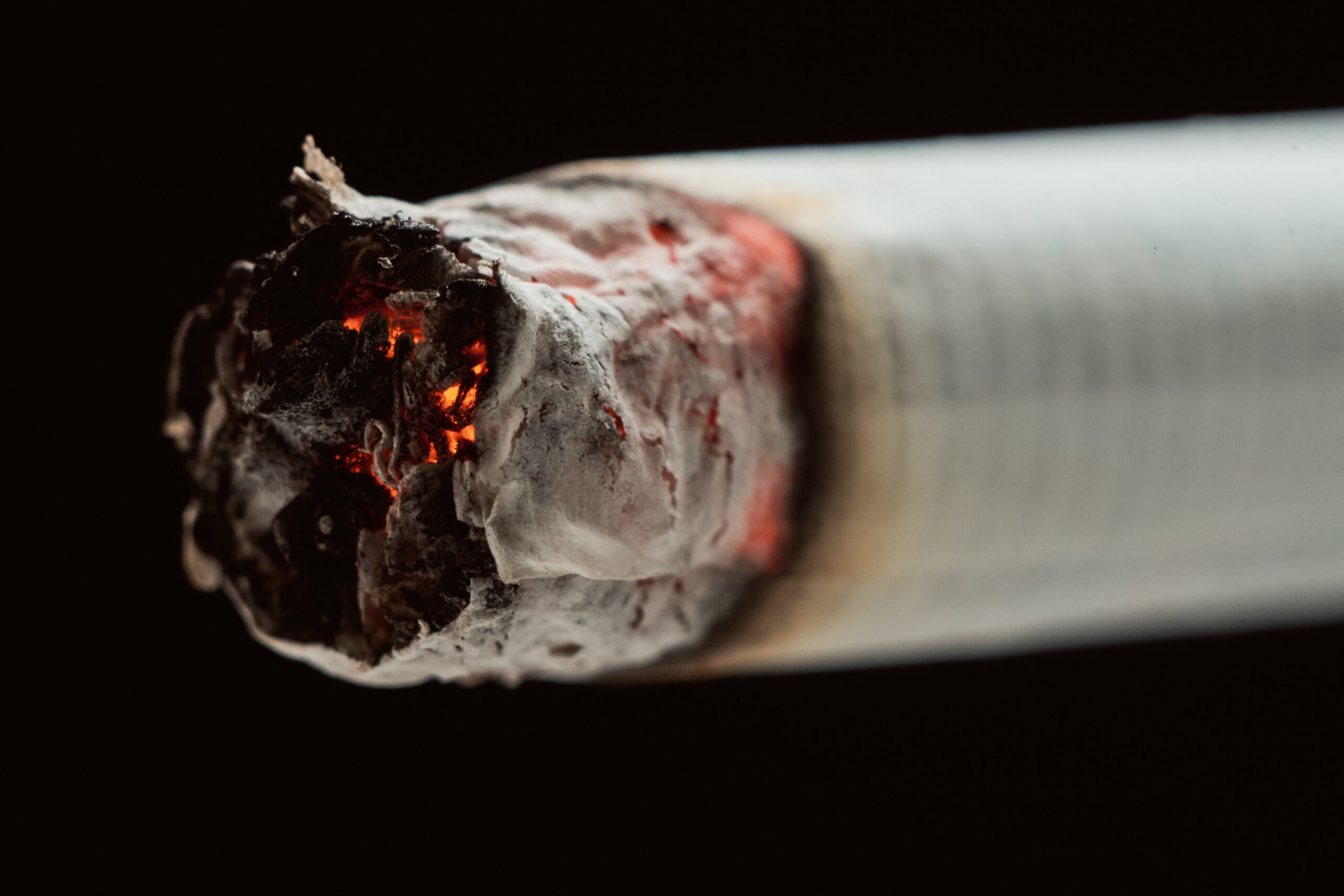
The Cigarette and its Sinister Cast of Harmful Components
13/10/2023
memorize this vocabulary
nicotine: A stimulant compound present in tobacco that causes addiction and triggers the release of dopamine in the brain, creating pleasure.
carbon monoxide: : a colorless, odorless gas produced during tobacco combustion that impairs the body's ability to transport oxygen, leading to asphyxia and health issues.
tara viscous, dark compound formed during tobacco combustion that contains thousands of harmful chemicals, some of which are carcinogenic.
cancer: a disease characterized by the abnormal and uncontrolled growth of cells in the body, which can be caused by tobacco and manifests in various types.
fertility: the ability to conceive and have offspring, which can be affected by tobacco consumption, causing menstrual irregularities in women and reducing sperm quality in men.

Read this article
El cigarrillo y su siniestro elenco de componentes dañinos.
In a dark corner of the world, a small cylinder wrapped in paper has been the center of attention for generations. The cigarette, a source of pleasure, companionship, and, unfortunately, addiction, has seduced countless people around the world. However, behind its appealing exterior lies a sinister cast of harmful components that undermine the health of those who fall into its clutches. In this article, we will explore the darkest secrets of the cigarette and the dangers it hides within.
Act I: The Lethal Addiction of Nicotine
Nicotine, extracted from tobacco leaves, takes center stage in this drama. When a smoker lights a cigarette, nicotine is released in the smoke and becomes the star of the show. This stimulating compound acts as a magician of the brain, performing a trick in which pleasure is the prize. Nicotine travels through the lungs, enters the bloodstream, and eventually reaches the brain, where it triggers a release of dopamine, the neurotransmitter of pleasure. This moment of ecstasy, as fleeting as it is powerful, becomes the hook of addiction.
The trap closes as the brain seeks that feeling of well-being time and time again. Nicotine, however, is not an indulgent lover; it demands unwavering loyalty. The smoker is ensnared in an endless cycle of craving and momentary satisfaction, and addiction looms over them like a dark shadow.
Act II: Carbon Monoxide, the Silent Killer
As the drama unfolds, carbon monoxide enters the stage, a stealthy character that acts behind the smoker's back. This colorless and odorless gas, produced during the combustion of tobacco, enters the lungs and begins its deadly dance. Carbon monoxide has a special affinity for hemoglobin, the molecule responsible for transporting oxygen in the blood. Its unhealthy love for hemoglobin means it binds to it more strongly than oxygen, hindering its transport to the body's organs and tissues.
The result is a silent suffocation. The heart beats harder, the brain suffers from oxygen deprivation, and the circulatory system is in constant danger. Carbon monoxide, in this act, becomes a specter that undermines health from within, condemning smokers to constant peril.
Act III: Tar, the Toxic Substance Dance
Tar, another member of the sinister cast, is a viscous and dark compound formed during the combustion of tobacco. It is a collective term used for thousands of chemical substances that are released in cigarette smoke.
This villain has more than 7,000 different chemical substances, many of which are highly toxic and harmful to health. Among these substances, there are more than 250 harmful compounds and over 60 carcinogens, substances with the potential to cause cancer.
Tar clings to the airways and lungs like a persistent intruder. Each puff of smoke is like an invitation to a toxic dance, where tar becomes the master of ceremonies. The chemicals in tar damage lung cells, clog airways, and significantly increase the risk of developing lung cancer and other tobacco-related cancers. In this act, tar is revealed as the principal accomplice in the spread of tragedy.
Act IV: The Deadly Consequences
The cigarette, with its sinister cast of harmful components, stages a series of deadly consequences that develop over time. As we progress through the acts, we see how these consequences impact the health of smokers and their quality of life.
Cancer, the Relentless Villain.
Cancer, one of the most notorious antagonists, emerges as a lethal threat. Lung cancer, the main villain of this story, is the most common and deadly among tobacco-related cancers. However, tobacco does not stop there; it is also associated with cancers of the mouth, throat, esophagus, pancreas, bladder, kidney, and other organs. Each of these cancers is a silent enemy that can emerge over time, leading to devastating consequences.
Cardiovascular Diseases, the Strike to the Heart.
Cardiovascular diseases, another nightmare in this plot, become prominent characters. Tobacco attacks the cardiovascular system, damaging blood vessels, raising blood pressure, and contributing to the buildup of plaque in the arteries. This can lead to heart diseases, heart attacks, and strokes. The heart, which in other stories is a symbol of love and life, becomes a battlefield where the consequences can be deadly.
Respiratory Diseases, the Struggle for Breath.
Lungs, those essential organs for life, become a stage of constant struggle. Smoking leads to an invasion of the airways, an occupation that results in diseases like chronic obstructive pulmonary disease (COPD) and chronic bronchitis. Breathing becomes a painful and difficult act, and the quality of life slowly fades.
Fertility, the Tragic Backdrop.
Even the hope of offspring is overshadowed in this drama. Women may experience irregular menstrual cycles, and men see the quality of their sperm decrease. Life itself becomes a silent victim of the battle that the cigarette wages against health and fertility.
Skin, the Marks of Suffering.
Even the skin, the body's protective shield, does not emerge unscathed. Oxygen deprivation and exposure to toxic chemicals accelerate skin aging, leaving wrinkles and marks in their wake. The skin, which should be a symbol of youth and vitality, becomes a reminder of the marks of suffering that the cigarette leaves behind.
Society in the Center of the Drama.
The cigarette not only affects individuals but also casts its shadow over society as a whole. Healthcare costs skyrocket, and healthcare systems are burdened with the treatment of tobacco-related illnesses. The economic and health costs accumulate in the billions of dollars, a burden that society must bear.
Furthermore, the cigarette also affects workplaces, where smokers may experience absenteeism and reduced productivity. Companies face challenges in maintaining a healthy workforce, and the economy suffers losses in productivity and increased healthcare costs.
Conclusion
The cigarette, with its sinister cast of harmful components, has been an enigmatic attraction for decades. Despite its apparent allure, it is essential to recognize that behind its facade of sophistication lie the ingredients of a tragedy. Nicotine, carbon monoxide, and tar are the main characters in this story, and their consequences spread far and wide throughout the body and society.
Unmasking the cigarette is crucial for making informed decisions about its consumption. Understanding the harmful components and the devastating consequences that can arise from this sinister cast is the first step in breaking free from the chains of addiction and preventing unnecessary suffering. The battle against the cigarette may be challenging, but the reward of a healthier, smoke-free life is an ending worth pursuing.
ANSWER THE FOLLOWING QUESTIONS
1. How does nicotine affect the brain and the body?
2. Why is carbon monoxide harmful to the body?
3. How many different chemical substances are found in tar?
4. Why is tar considered harmful?
